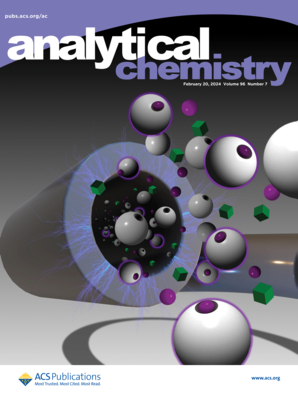IF 6.7
1区 化学
Q1 CHEMISTRY, ANALYTICAL
引用次数: 0
摘要
开发具有高灵敏度和特异性的生物分子传感技术仍然是现代分析科学的一个重要目标。分子摆动传感是一种新型的无试剂方法,能够直接检测生物液体中的各种生物分子。这种传感方法在很大程度上依赖于分子探针在溶液中的流体动力阻力的调节,因此流体动力直径的改变可以传递生物分子的相互作用。在这里,我们探讨了在基于摆锤的系统中使用纳米抗体作为替代受体的问题,因为纳米抗体体积小、亲和力强。我们以炎症指标白细胞介素-6(IL-6)为目标,比较了纳米抗体与整合到分子摆系统中的适配体和抗体的性能。与其他受体相比,纳米抗体分子钟摆的传感器响应和灵敏度都有所提高,能够在 IL-6 的低生理范围内实现精细的检测控制。此外,我们还展示了纳米抗体传感器在复杂的生物基质和生理温度下发挥作用的能力。本文章由计算机程序翻译,如有差异,请以英文原文为准。

Nanobody Receptors Enable High-Sensitivity Monitoring of IL-6 Using Molecular Pendulum Bioanalysis
The development of biomolecular sensing technologies with high sensitivity and specificity remains an important goal in modern analytical science. Molecular pendulum sensing has emerged as a new reagentless method capable of detecting a wide array of biomolecules directly in biological fluids. This sensing approach relies heavily on the modulation of hydrodynamic drag of molecular probes through solution, such that alterations in hydrodynamic diameter can transduce biomolecular interactions. Here, we explore the use of nanobodies as an alternative receptor in pendulum-based systems due to their small size and robust affinities. We compare the performance of nanobodies with that of aptamers and antibodies integrated into the molecular pendulum system by targeting the inflammatory indicator interleukin-6 (IL-6). Nanobody molecular pendulums demonstrate enhanced sensor response and sensitivity compared to those of the other receptors, enabling fine control over detection in the low physiological range of IL-6. In addition, we demonstrate the ability of nanobody sensors to function in complex biological matrices and at physiological temperature.
求助全文
通过发布文献求助,成功后即可免费获取论文全文。
去求助
来源期刊

Analytical Chemistry
化学-分析化学
CiteScore
12.10
自引率
12.20%
发文量
1949
审稿时长
1.4 months
期刊介绍:
Analytical Chemistry, a peer-reviewed research journal, focuses on disseminating new and original knowledge across all branches of analytical chemistry. Fundamental articles may explore general principles of chemical measurement science and need not directly address existing or potential analytical methodology. They can be entirely theoretical or report experimental results. Contributions may cover various phases of analytical operations, including sampling, bioanalysis, electrochemistry, mass spectrometry, microscale and nanoscale systems, environmental analysis, separations, spectroscopy, chemical reactions and selectivity, instrumentation, imaging, surface analysis, and data processing. Papers discussing known analytical methods should present a significant, original application of the method, a notable improvement, or results on an important analyte.
 求助内容:
求助内容: 应助结果提醒方式:
应助结果提醒方式:


